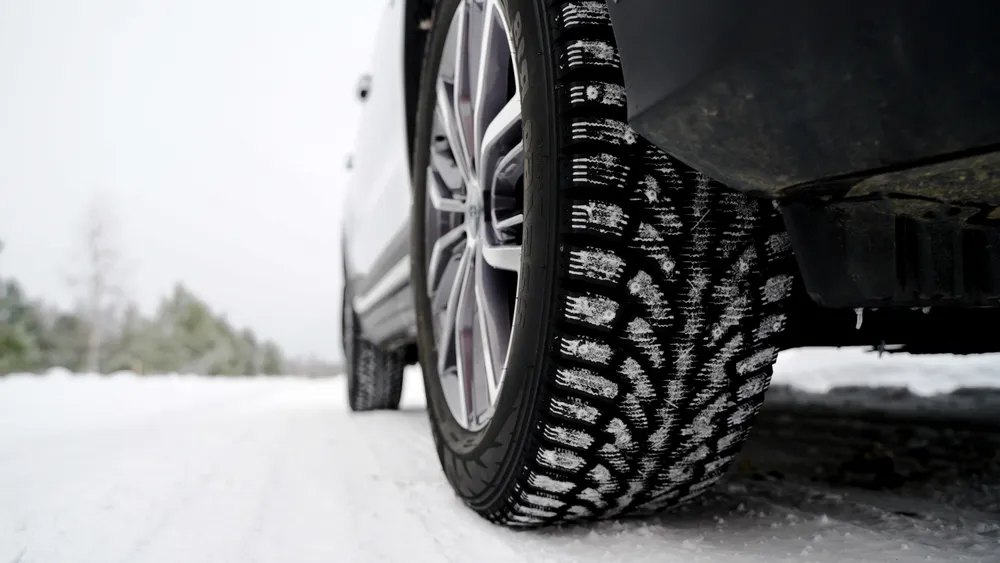As winter approaches, it’s essential to get your car ready for the colder months. Slippery roads and icy conditions require more attention to safety and maintenance. Many accidents happen because drivers don’t prepare their vehicles for winter. But by taking a few key steps, you can ensure your car is ready for the challenges ahead.
 Shutterstock: Ultraskrip
Shutterstock: UltraskripSwitch to Snow Tires for Better Traction
One of the most crucial things you can do to prepare your car for winter is to change to snow tires. Snow tires are designed to provide extra grip on icy or snowy roads. Unlike all-season tires, snow tires are made from a softer rubber that remains flexible in cold temperatures, offering better traction. This flexibility allows the tires to grip the road more effectively, reducing the risk of sliding. Make sure to change your tires before the first snowfall to avoid getting caught off guard by winter conditions.
Check and Refill Your Fluids
Winter weather can take a toll on your car’s fluids, which are essential for keeping everything running smoothly. Antifreeze, for example, helps to prevent your engine from freezing in extreme cold. Make sure your coolant levels are appropriate and that you’re using a 50/50 mix of antifreeze and water. Windshield washer fluid is another key item to check. Regular washer fluid may freeze in cold temperatures, so consider switching to a winter formula that can handle freezing weather. This will keep your windshield clear, improving your visibility during snowstorms.
Test Your Battery Strength
Cold weather can reduce your car battery’s power, making it harder for your car to start in the winter. A weak battery can leave you stranded in freezing conditions, so it’s a good idea to test it before the temperature drops. Most car repair shops can test your battery’s strength and let you know if it’s time for a replacement. If your battery is more than three years old, consider replacing it before winter. In extremely cold temperatures, even a strong battery can struggle, so keeping jumper cables in your car is always a smart move.
Inspect Your Wiper Blades and Lights
Visibility is crucial when driving in winter, and that’s why it’s important to inspect your wiper blades and lights. Worn-out wiper blades can smear snow and ice across your windshield, reducing your ability to see. Consider replacing them with winter-specific blades that are designed to handle snow and ice buildup. In addition, make sure all your car’s lights are working properly. Foggy headlights or burned-out bulbs can make it harder for you to see and for others to see you. Clean the lenses and replace any faulty bulbs to ensure maximum visibility during winter driving.
Ensure Your Heater and Defroster Work Properly
Before winter hits, it’s essential to ensure your car’s heating system and defroster are in good working condition. A properly functioning heater will keep you warm, while a reliable defroster ensures that your windows remain clear and free from fog or frost. Turn on the heater to check if it blows hot air, and test the defroster to see if it effectively clears your windshield. If you experience any issues, have these systems inspected to avoid uncomfortable and unsafe conditions while driving in the cold.
Refresh Your Emergency Kit
Winter driving can be unpredictable, so it’s wise to prepare for emergencies. Keeping an emergency kit in your car can help you stay safe if you get stuck in the snow or experience a breakdown. A good winter emergency kit should include items like blankets, warm clothing, snow boots, non-perishable food, and bottled water. Other helpful items include flashlights, first-aid supplies, and a shovel to dig your car out of the snow. Additionally, you may want to keep road salt or sand in your car to help with traction if you get stuck on an icy road.
Winter Car Preparation Checklist
Before heading out onto winter roads, run through this checklist to ensure your car is fully winter-ready:
- Snow Tires: Install snow tires for better grip on icy or snowy roads.
- Fluids: Check antifreeze and windshield washer fluid levels.
- Battery: Test the battery and replace it if it’s time.
- Wiper Blades and Lights: Replace old wiper blades and check all lights.
- Heater and Defroster: Confirm these systems are working properly.
- Emergency Kit: Equip your vehicle with essential winter survival items.
This checklist can help you stay safe and ready for winter’s challenges on the road.
Drive Confidently This Winter
Winterizing your car can make a huge difference in how well it handles the cold weather. From switching to snow tires to keeping an emergency kit, each step you take boosts your safety on the road. Don’t wait until the first snowstorm to get your car ready. Take the time now to ensure your vehicle is prepared for whatever winter throws your way.

